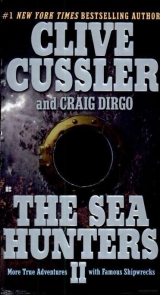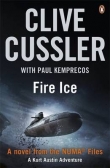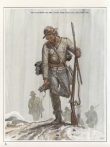
Текст книги "The Sea Hunters II: More True Adventures with Famous Shipwrecks"
Автор книги: Clive Cussler
Соавторы: Craig Dirgo
Жанры:
Прочая документальная литература
,сообщить о нарушении
Текущая страница: 26 (всего у книги 27 страниц)
PART FOURTEEN
I America’s Leonardo da Vinci
America’s Leonardo da Vinci
1792, 2001
Though we don’t often find what we search for, it is satisfying to bring closure to a piece of history that has been surrounded in mystery. One such project was the hunt for Samuel Morey’s boat, Aunt Sally.
Legends persisted for almost two centuries of a boat sunk in the waters of Lake Morey in Fairlee, Vermont, about a mile west of the Connecticut River. With the passage of time, colorful variations on the story have obscured the facts.
What we do know is that Samuel Morey was a true genius whose name and accomplishments are known to very few today. Born in 1763, he became a prolific inventor, whose experiments with light, heat, and steam were half a century ahead of his time. Though it is well recorded that James Watt invented the steam engine, Morey is considered the first to put a steam engine in a boat.
His first patent was signed by President George Washington in 1793, for a steam-powered roasting spit. His next patent was for the use of steam to propel a boat and was signed by Thomas Jefferson, who was then the secretary of state. He constructed the hull and the necessary machinery at the sawmill and iron forge he owned. History has at least credited Morey with creating the use of the first paddle wheels. He is also acclaimed – perhaps grudgingly by some historians – as having built the first successful machine-powered vessel.
His first boat was small, with only enough room for one companion, but it worked. To this day, no one knows what he named this little historic vessel. Morey’s maiden voyage was from Orford, New Hampshire, up the Connecticut River to Fairlee, Vermont, and back. This was as early as 1792, more than fourteen years before Robert Fulton’s first trial trip up the Hudson River.
A short time later, Morey was encouraged to travel to New York and display a model of his boat. He met a wealthy backer of inventions named Chancellor Livingston. The entrepreneur was deeply taken with Morey’s creation and introduced him to Robert Fulton, who was also fascinated by the sight of a working model of a steamboat. Morey was treated with great respect by Livingston and Fulton, who suggested minor modifications. The two New Yorkers then offered Morey $10,000 if he would make the alterations and demonstrate a working model.
He returned home and completed the work with great success, mounting the paddle wheel in the stem, an innovation that was not employed until many years later for boats traveling the Missouri and Mississippi Rivers. It was recorded that, during the effort, Livingston made more than one trip to Morey’s workshop to study the progress and take notes on Morey’s success.
Then, when Morey returned to New York, he was greeted with great coldness and indifference. No mention was made of the $10,000, and Fulton and Livingston simply brushed him off. The two men had seen all they had to see. Morey’s secret invention had been fully acquired and was now no longer needed. The result was that Fulton, backed financially by Livingston and with the influence of powerful men in the New York statehouse, succeeded in building a large boat on Morey’s principles, mainly the paddle wheels, which went down in history as the first successful steamboat.
Years later, it was clearly proved that Samuel Morey had taken out the necessary patents for the operation of steam-powered boats several years before Fulton, so there was an obvious case of infringement. But Morey, described as a warm and retiring sort of person, did not want the trouble or the expense of a court case, and probably realized he had little chance of winning over the powers that be in New York. To be sure, he made appeals, but he never followed through, lacking time and money.
Truth has always been on Morey’s side, but unfortunately his ingenuity has been mostly forgotten, except by local historical organizations.
Morey also devised gaslights and heated his house for years with what he called “water gas.” During his life, no other man was granted as many patents as Samuel Morey. He built dams, intricate irrigation canals, and fish-stocking ponds so he could study their behavior. Remains of a flume he erected to shoot logs down to his lumber mill can still be seen. When the Connecticut River was opened for navigation, it was Sam Morey who designed and built the locks at Bellows Falls, Vermont.
After the debacle with Fulton, he returned home to Orford and continued work on his engines, building a rotary steam engine and then a turpentine-vapor engine. In 1826, he patented an internal combustion engine. Far ahead of his time, Morey installed his first small gas engine in a wagon. When he started it up, the wagon lurched forward and smashed through his workshop wall. He beat Charles Duryea’s first gasoline automobile by fifty years.
He constructed a larger engine and dropped it in a boat nineteen feet long and five feet wide, painted white with red streaks and black gunwales. Fitted with paddle wheels on the side, the vessel was christened Aunt Sally.
After refitting her with a vapor-type engine, Morey operated Aunt Sallyon Fairlee Lake, later named after him, for a year or more, hauling lumber and other materials back and forth across the lake.
Then, mysteriously, the first internal combustion-powered craft in history disappeared.
Some said that Morey sunk it in a fit of anger, but a friend of Morey’s said, “No Vermont Yankee would sink something that was still useful just because he was mad.”
Another story is that it was stolen in the dead of the night by Morey’s enemies from New York, filled with stones and scuttled. Still another admission, from a group of three boys who claimed they sank the boat, has added to the enigma.
There was an attempt to find the boat in 1874 by dragging a grappling hook. But the pickerel grass was thick and reached as high as six feet, so the grapple had to be cleaned every twelve feet, and nothing was found.
Other attempts were made, with no success. Doc Harold Edgerton, a trustee of NUMA and a grand old inventor himself, gave it a try in 1984. He used sidescan sonar, which he created and developed to search the lake. But Doc did not find Aunt Sally.As he so eloquently put it, “I don’t like to give up. I’ve been on many projects where we never found what we were looking for, others where we did find what we were looking for, and others where we found things we weren’t looking for at all.”
* * *
In July of 1999, I received a call from Michael Colin Moore, who I believe was a descendant of Morey. He related the story of the inventor, and suggested that I might be interested in searching for the lost boat.
After researching the matter with the help of Hester Gardner, curator of the Fairlee Historical Society, I decided to give it a go. I contacted my old survey pal, Ralph Wilbanks, and arranged an expedition. Though Doc Edgerton had swept the lake with his sidescan sonar fifteen years before, Ralph decided to use a sidescan again in hopes that a newer, advanced navigation system might make a difference. I learned that a pole could be easily pushed into the bottom mud up to five feet. This, of course, led me to believe that any chance of finding the long-lost boat would depend heavily on a magnetometer survey to detect any iron that Morey had used to assemble the boat as well as the engine. After 175 years, it seemed likely that the boat had sunk into the soft mud.
In September of 2000, Ralph arrived in Fairlee, Vermont, with Diversityin tow, along with his experienced underwater survey associate Shea McLean. He was joined by writer Jayne Hitchcock and her husband Chris.
Lake Morey is in a pretty setting, set in a valley amid wooded hills and surrounded by picturesque homes. Five hundred eighty acres of water, it is shaped like a sea slug, forty-two feet at its deepest point. Several probes into the bottom revealed it to be very soft up to eighteen feet.
Ralph divided the lake into search lanes on his computer. He began mowing the lawn with a cesium magnetometer towed off the port side, while the sidescan sonar sensor was towed off the starboard stem. Two computers were tied in with the GPS positioning system. The software then tracked the fifty-foot lanes. After two days of recording several small hits, they decided to spend the third day diving on them to investigate. After marking each one with a buoy, Ralph and Shea traded going over the side. They found old barrels at one site and railroad ties at another. The most promising target turned out to be a forty-foot curved section of pipe.
On the final day, while cruising toward the dock, a boat approached and asked if they could search for a wallet belonging to a boater who was lost overboard. Ralph thought that it would be the same as searching for the proverbial needle in a haystack, but the man persisted, saying there was a medal in the wallet that belonged to the boater’s son, who had recently died. Ralph and Shea looked at each other, knowing they couldn’t refuse.
The general area where the wallet had sunk was pointed out, and Shea volunteered to go in. Everyone thought it was a lost cause, but in less than three minutes Shea broke the surface with his hand raised in the air, clutching the wallet. The boater had tears in his eyes as he showed everyone the medal. Then he gave Shea two soggy fifty-dollar bills. Shea tried to refuse, but the man would not take no for an answer. That night, Shea treated Ralph and the Hitchcocks to dinner.
Ralph covered the entire lake from shore to shore, even dragging the sensor through the growth along the banks. Over two hundred lanes were searched, with no solid results. Ralph and I strongly believe that Morey’s boat was never scuttled in the lake. Its most likely demise probably involved being broken up either for firewood or lumber.
The real pity is that Morey’s ingenious power plant, possibly the first internal combustion engine in the world, was lost to the engineers of the future, who would have given their eye-teeth to study it.
The residents around the lake believe that Morey’s wonderful boat is still out there, waiting to be discovered. But in our minds, the mystery has been solved. Aunt Sallyis not in Morey Lake. The brilliant inventor most likely scrapped her.
As the man suggested, “No Vermont Yankee would throw away a good boat and engine.”
POSTSCRIPT FROM THE AUTHOR
The National Underwater & Marine Agency (NUMA) has a proud record of achievement. Never has so much been accomplished with so few people with so little financial or technical help.
We’re not a giant corporation – an oil company or university with large grant funding – nor are we a department of the government with a billion-dollar budget. We have very few donations of consequence. Douglas Wheeler, a Chicago businessman and NUMA trustee, has been a generous contributor, as has ECO-NOVA Productions of Nova Scotia, which has engaged me to narrate a series of Sea Huntersdocumentaries on famous shipwrecks. And, except for Schonstedt Instruments, we have rarely been offered equipment without paying the going rental price.
NUMA is a nonprofit, volunteer foundation dedicated to preserving our maritime heritage through the discovery, archaeological survey, and conservation of historic shipwrecks and their artifacts. Our purpose is also to reinforce public appreciation for our maritime past, present, and future by initiating and supporting projects designed to uncover and explore historically significant underwater sites before they are lost and gone forever.
Our goals include the protection of these historic sites through public information programs and to make available our archaeological reports and data on technical progress while perpetuating the names and legends of the sea-loving men and women who came before us.
I used to beg for funding, but because we search for history with no monetary return, few are willing to step forward and contribute. If I were to say we were searching for treasure, with our track record donors would probably line up for a city block. I wish I had a nickel for every person who has offered to help with funding, a boat, or equipment and then never called again.
Perhaps it’s all for the best that NUMA is primarily funded through my book royalties.
Why do I do it? Why do I initiate so many expeditions that are often an exercise in futility? One reason is that if it’s lost, I’ll look for it.
Why do I pour my money into the sea?
The answer probably lies in how I explain my philosophy to people who think I belong in a rubber room under restraint:
When the time comes and I am lying in a hospital bed two gasps away from the great beyond, I’d like the phone to ring. Then as a beautiful, young, buxom blond nurse leans over me and holds the receiver to my ear, the last words I hear before I drift off are those of my banker telling me my account is $10.00 overdrawn.
That’s the way to go.
Or, as I tell the audience when closing the Sea Huntersdocumentaries:
Now it’s your turn to get up off of the couch and go into the deserts, go into the mountains, go under the lakes, the rivers and the seas, and search for history.
You’ll never have a more rewarding adventure.
CURRENT LIST OF NUMA SEARCH SURVEYS AND DISCOVERIES
1. ACETON(H.M.S.)
British fifty-gun frigate that stranded and burned during the Revolutionary War battle off Fort Moultrie, South Carolina, in 1776.
2. ALEXANDER NEVSKI
Russian steam frigate that grounded on the east coast of Denmark in 1868 with the Russian crown prince aboard. All aboard were rescued.
3. AMERICAN DIVER
Pre– HunleyConfederate submarine that foundered under tow off Fort Morgan, Alabama.
4. ARCTIC
British steamship that grounded on the east coast of Denmark in 1868.
5. ARKANSAS(C.S.S.)
Confederate ironclad that battled the entire Mississippi River fleet and won. Burned by her crew above Baton Rouge, Louisiana, to avoid capture in 1862.
6. BLUCHER
German heavy cruiser sunk during the Battle of Dogger Bank in 1916.
7. CARPATHIA
Ship that rescued the survivors of Titanic.Torpedoed by U-55in 1915.
8. CARONDELET(U.S.S.)
Venerable Union navy ironclad that fought in more battles in the Civil War than any other warship. Built by genius inventor James Eads. Sank in the Ohio River in 1873.
9. CHARING CROSS
British freighter torpedoed by German U-boat off Flamborough Head, England, in 1916.
10. CHICAGO
Ten-thousand-ton British freighter torpedoed by German U-boat off Flamborough Head, England, in 1918.
11. COLONEL LOVELL(C.S.S.)
Cotton-clad Confederate ram. Rammed and sunk during the battle for Memphis in 1862.
12. COMMODORE JONES(U.S.S.)
Former New York ferryboat that became a Union gunboat. Destroyed by sophisticated Confederate electrical mine in the James River in 1864.
13. COMMONWEALTH
British freighter sunk by German U-boat off Flamborough Head, England, in 1915.
14. CUMBERLAND(U.S.S.)
Union navy frigate. First vessel to be defeated and sunk by armored vessel. Rammed by the Confederate ironclad Merrimackat Newport News, Virginia, in 1862. More than 120 of her crew killed.
15. DEFENCE(H.M.S.)
British heavy cruiser sunk during Battle of Jutland in 1916.
16. DREWRY(C.S.S.)
Confederate gunboat that fought for three years on the James River before being sunk by Union artillery fire in Trent’s Reach in 1865.
17. FLORIDA(C.S.S.)
Famous Confederate sea raider that captured and sank nearly fifty U.S. merchant ships during the Civil War. Captured at Bahia, Brazil, and scuttled near Newport News, Virginia, in 1864.
18. FREDERICKSBURG(C.S.S.)
Confederate ironclad of the James River fleet. Blown up by her crew at Drewry’s Bluff in 1865.
19. GAINES(C.S.S.)
Confederate gunboat in the battle of Mobile Bay. Run aground at Fort Morgan and burned in 1865.
20. GALVESTON GRAVEYARD OF SHIPS
Upward of a dozen ships ran aground between 1680 and 1880 off Galveston Island, Texas.
21. GENERAL BEAUREGARD(C.S.S.)
Confederate side-wheel ram that fought in the battle of Memphis. Heavily damaged, she sank along the west bank of the Mississippi River in 1862.
22. GENERAL SLOCUM
New York excursion steamer that burned and ran aground off Brothers Island, New York, in 1904.
23. GENERAL THOMPSON(C.S.S.)
Confederate side-wheel ram damaged during the battle for Memphis and run aground in 1862.
24. GLUCKHAUF
Prototype of modem oil tanker. Stranded on Fire Island, New York, in 1893.
25. GOVERNOR MOORE(C.S.S.)
Confederate gunboat that was converted from passenger steamer. Fought in battle of New Orleans, then was run aground and burned by her crew to avoid capture in 1862. Loss of sixty-four crew.
26. GREAT STONE FLEET
Large numbers of contacts in area where New England whaling ships were scuttled to block Charleston Harbor during the Civil War.
27. HAWKE(H.M.S.)
British cruiser sunk by U-9 sixty miles off the coast of Scotland in 1915. Loss of 348.
28. HOUSATOMC(U.S.S.)
Union navy sloop of war. First warship in history to be sunk by a submarine, the Confederate torpedo boat Hunleyin 1864. Five of her crew were lost.
29. HUNLEY(C.S.S.)
First submarine in history to sink a warship. After torpedoeing the U.S.S. Housatonicoff Charleston, South Carolina, in February of 1864, she vanished.
30. INDEFATIGABLE(H.M.S.)
British battle cruiser sunk by German navy during the Battle of Jutland in 1916. Loss of 1,000-plus.
31. INVINCIBLE(H.M.S.)
British battle cruiser sunk by German navy during the Battle of Jutland in 1916. Loss of 1,026.
32. INVINCIBLE(R.T.N.)
Armed schooner that was the first flagship of the Republic of Texas Navy. Captured arms and supplies from Mexican merchant that were later turned over to General Sam Houston. Sunk in battle off Galveston, Texas, in 1837
33. IVANHOE
Confederate blockade runner captured by Union gunboats off Fort Morgan, Mobile Bay, Alabama, and destroyed in 1863.
34. JAMUTOWN
Passenger steamer seized by Confederacy and later fought with Merrimack.Later sunk as an obstruction below Drewry’s Bluff in 1862.
35. KEOKUK(U.S.S.)
Unique Union monitor with twin nonrevolving gun turrets that was referred to as a citadel monitor. Took more than ninety hits by Confederate guns off Charleston, South Carolina, in 1863. Sunk soon after.
36. KIRKWALL
British steamer grounded on the east coast of Denmark in 1874.
37. L’AIMABLE
Explorer La Salle’s flagship. Grounded in Matagorda Bay, Texas, in 1685.
38. LEOPOLDVILLE
British troop transport that was torpedoed on Christmas Eve in 1944 off Cherbourg, France. Loss of more than eight hundred American soldiers.
39. LEXINGTON
Extremely fast side-paddle steamboat constructed by Cornelius Vanderbilt. In 1840 she burned and sank in Long Island Sound, New York, with a loss of 151 passengers and crew.
40. LOUISIANA(C.S.S.)
Mammoth Confederate ironclad mounting sixteen guns. Never finished, she was moored along shore and fought in the battle of New Orleans. Sunk by her crew to avoid capture in 1862.
41. MANASSAS(C.S.S.)
The first armored ship built in North America and the first to see battle. Designed as a ram, she burned and sank in the Mississippi River during the battle of New Orleans in 1862.
42. MARY CELESTE
Famous mystery ship recovered with no one aboard. Later intentionally run aground on the Reef of Rochelais, Haiti, in 1885.
43. MERMMACK
NUMA found scattered contacts at Craney Island, Portsmouth, Virginia, where ship was blown up to avoid capture. Wreckage believed to have been dredged out of existence.
44. MISSISSIPPI(U.S.S.)
U.S. Navy side-paddle frigate damaged in Battle of Port Hudson, Louisiana, in 1863. Later drifted loose and blew herself to smithereens.
45 . NEW ORLEANS
First steamboat down the Mississippi River. Snagged on stump and sank across from Baton Rouge, Louisiana, in 1814.
46. NORSEMAN
Confederate blockade runner that was run ashore off Isle of Palms, South Carolina, in 1865.
47. NORTHAMPTON
Confederate supply ship that was sunk as an obstruction below Drewry’s Bluff in 1862.
48. ODIN
Early Swedish steamship that ran ashore off the east coast of Denmark in 1836.
49. PATAPSCO(U.S.S.)
Passaic-class Union monitor that fought throughout the siege of Charleston, South Carolina. Sank after striking a Confederate mine in the channel off Fort Moultrie in 1865. Loss of sixty-two.
50. PATHFINDER(H.M.S.)
Second ship sunk by a submarine and first by a German U-boat. Torpedoed by U-21 in 1914.
51. PHILLIPE(U.S.S.)
Union navy gunboat destroyed by Confederate guns during the battle of Mobile Bay in 1864.
52. PLATT VALLEY
Side-wheel steamer that snagged and sank on the wreck of General Beauregardin 1867.
53. PT-109
John F. Kennedy’s World War II command. Run through by Japanese destroyer Amagiri in Blackett Strait, Solomon Islands, in 1943.
54. RACCOON
Confederate blockade runner captured by Union gunboat when leaving Charleston Harbor with a load of cotton. Burned in 1863.
55. RATTLESNAKE
Confederate blockade runner caught by Union navy while trying to enter Charleston Harbor with a load of arms. Burned in 1863.
56. RICHMOND(C.S.S.)
Confederate ironclad that guarded the reaches of the James River. After the fall of Richmond she was destroyed by her crew near Chaffin’s Bluff in 1865.
57. RUBY
Successful Confederate blockade runner that was finally chased ashore on Folly’s Island, South Carolina, an
58. S-3S
German destroyer sunk during the Battle of Jutland in 1916.
59. SAMT PATRICK
Four-hundred-ton steamer that burned and sank above Memphis in 1868.
60. SHARK(H.M.S.)
British destroyer sunk during the Battle of Jutland in 1916.
61. STONEWALL JACKSON
Confederate blockade runner that was formerly the British steamer Leopard.Ran aground on Isle of Palms, South Carolina, in 1864.
62. SULTANA
Side-paddle-wheel steamboat that burned in the Mississippi River with a loss of two thousand Union soldiers, making it the worst North American ship disaster.
63. TORPEDO RAFT
The remains of the torpedo raft towed by Weehawken.Located at the north end of Marsh on Morris Island, South Carolina.
64. U– 12
German submarine that sank after being rammed by the British cruiser Ariel off Scotland in 1915.
65. U– 20
German U-boat that sank the Lusitania.Stranded on Jutland shore, Denmark, in 1916.
66. U– 21
First German U-boat to sink a ship. Foundered while under tow in the North Sea in 1919.
67. UB-74
German U-boat that sank after being depth-charged off Weymouth, England, in 1916.
68. V-48
German cruiser sunk during the Battle of Jutland in 1916.
69. VARUNA(U.S.S.)
Union navy gunboat that was rammed three times during the battle of New Orleans. Credited with sinking six vessels before being forced ashore and burned in 1862.
70. VICKSBURG
Britsh freighter stranded on Fire Island, New York, in 1875.
71. VIRGINIA II(C.S.S.)
Confederate ironclad that prevented General Grant’s army from crossing the James River to take Richmond. Burned by her crew to avoid capture at Drewry’s Bluff in 1865.
72. WARATAH
Passenger liner that disappeared off the coast of Africa in 1911. Two hundred passengers and crew lost.
73. WEEHAWKEN(U.S.S.)
Led the first attack on Fort Sumter. The only Union monitor to capture a Confederate ironclad in battle. Sank as a result of a storm off Charleston, South Carolina, in 1864.
74. WIESBADEN
German heavy cruiser sunk during the Battle of Jutland in 1916.
75. ZAVALA(R.T.N.)
Passenger steamboat converted to armed warship by the Republic of Texas Navy. Probably the first armed steamship in North America. Grounded in Galveston Bay, Texas, in 1842.








